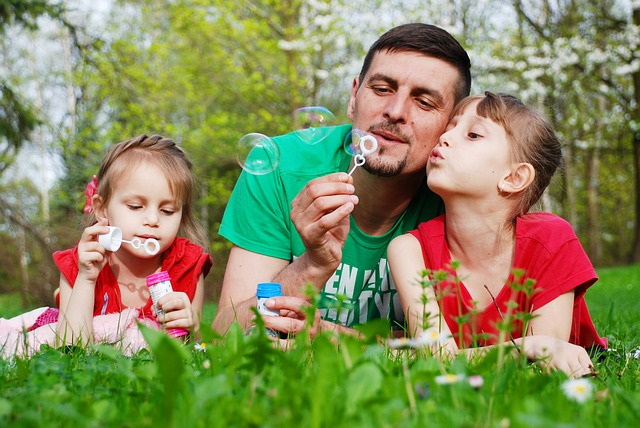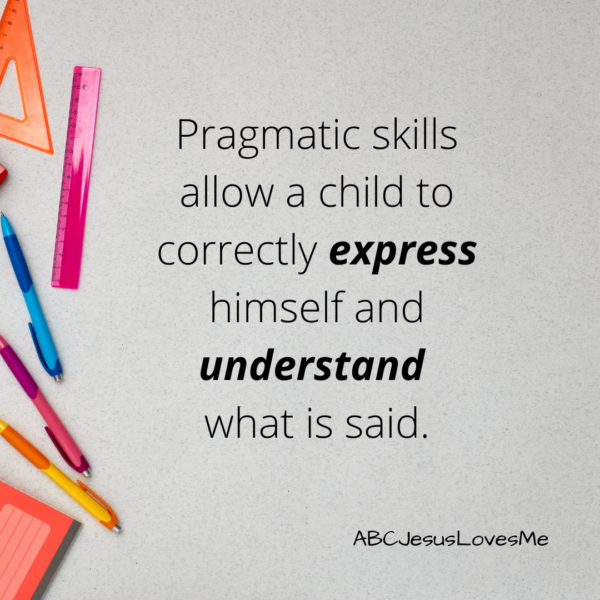Pragmatics. Depending on your education and experiences, pragmatics may or may not be a word that you are familiar with.
Even with my education background, it wasn’t until we were neck deep in Bubs’ delays that I began to understand what pragmatics is and why it is so important.

What is Pragmatics?
Pragmatics is the study of language in a social setting. Think communication and social language skills. These skills allow a child to correctly express himself and understand what is said. Think emotions and facial expression.
Just as children struggle managing their emotions, many children also battle expressing themselves correctly and understanding what is being “said” to them by another’s expressions and body language. While some children learn by example, others must be taught.
According to the American Speech-Language-Hearing Association*, pragmatics involve 3 major communication skills.
- Using language for different purposes. This means the child understands the difference between the following:
– greeting (e.g. hello, goodbye)
– informing (e.g. I’m going outside to play.)
– demanding (e.g. Give me a drink.)
– promising (e.g. I’m going to get you a fork.)
– requesting (e.g. May I please have the train?) - Changing language according to the needs of the listener or situation.
– talk differently to a baby vs. an adult
– provide background information to those unfamiliar with a situation
– speaking differently at a playground vs. library. - Following rules of conversation and storytelling.
– taking turns in conversation
– staying on topic
– introducing topics of conversation
– rephrasing when misunderstood
– understanding verbal and nonverbal signs (e.g. “stop” vs. raising your hand)
– using facial expressions and eye contact
You probably already have in mind a child or adult who struggles with pragmatics!

Can Pragmatics Be Improved?
Parents and teachers can help children use language appropriately in social situations. Here are three tips to get you started.
Idea #1
Ask open-ended questions to further discussion. For example, use Relational Talk instead of only Instructional Talk. (There is an entire blogpost and podcast teaching you how to do this.) Open-ended questions cannot be answered with a simple yes or no. They require the child to come up with an actual idea and then express that thought to another person. You might ask a child, “What was the best part of your day?” or “What was your favorite part of the game we played last night?” Once you get the hang of it, open-ended questions will pop up naturally throughout the day as you interact with the child. But in the beginning, you’ll want to be intentional to ask this kind of question.
Idea #2
As you read, discuss the facial expressions of the characters in the pictures and illustrations. And, talk about the emotions of the characters based on what words they say or the situations they are in.
Discuss the shape of the character’s eyes and eyebrows. Discuss the shape of the character’s mouth. Both the mouth and eyes can help you discern what the person is thinking or feeling. Also look to see what the hands are doing as they speak volumes.
When you read a Bible story, discuss how the Bible character is feeling. For example, the disciples were scared of the storm as their boat was being blown about in the wind (Matthew 8:23-27). The shepherd was so excited to find his lost sheep (Luke 15:3-7). Joseph’s brothers were angry when he received a colorful coat, and they did not (Genesis 37).
Idea #3
Ask pragmatic questions and then discuss the answers. Here are some examples:
Q.A. What should you do when you sneeze?
Q.A. Tell me about your favorite pizza toppings.
Q.A. What do you do if you receive a birthday gift that you don’t like?
Q.A. You walk into a room and see your sister crying. What should you do?
Following the child’s answer, always ask the child “why” to provide an opportunity for the child to support his answer. This also allows you to understand the child’s rationale for his answer.

And this is just the beginning of this topic. Join us in a few weeks on this blog when I will share Pragmatic Milestones to make sure your child is developing at an appropriate level.

*Source Link is Broken